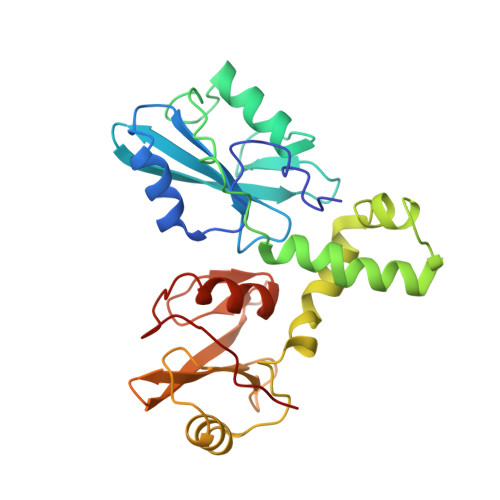Modification by covalent reaction or oxidation of cysteine residues in the tandem-SH2 domains of ZAP-70 and Syk can block phosphopeptide binding.
Visperas, P.R., Winger, J.A., Horton, T.M., Shah, N.H., Aum, D.J., Tao, A., Barros, T., Yan, Q., Wilson, C.G., Arkin, M.R., Weiss, A., Kuriyan, J.(2015) Biochem J 465: 149-161
- PubMed: 25287889
- DOI: https://doi.org/10.1042/BJ20140793
- Primary Citation of Related Structures:
4XZ0, 4XZ1 - PubMed Abstract:
Zeta-chain associated protein of 70 kDa (ZAP-70) and spleen tyrosine kinase (Syk) are non-receptor tyrosine kinases that are essential for T-cell and B-cell antigen receptor signalling respectively. They are recruited, via their tandem-SH2 (Src-homology domain 2) domains, to doubly phosphorylated immunoreceptor tyrosine-based activation motifs (ITAMs) on invariant chains of immune antigen receptors. Because of their critical roles in immune signalling, ZAP-70 and Syk are targets for the development of drugs for autoimmune diseases. We show that three thiol-reactive small molecules can prevent the tandem-SH2 domains of ZAP-70 and Syk from binding to phosphorylated ITAMs. We identify a specific cysteine residue in the phosphotyrosine-binding pocket of each protein (Cys39 in ZAP-70, Cys206 in Syk) that is necessary for inhibition by two of these compounds. We also find that ITAM binding to ZAP-70 and Syk is sensitive to the presence of H2O2 and these two cysteine residues are also necessary for inhibition by H2O2. Our findings suggest a mechanism by which the reactive oxygen species generated during responses to antigen could attenuate signalling through these kinases and may also inform the development of ZAP-70 and Syk inhibitors that bind covalently to their SH2 domains.
- *Department of Molecular and Cell Biology and Department of Chemistry, California Institute of Quantitative Biosciences and Howard Hughes Medical Institute, University of California, Berkeley, CA 94720, U.S.A.
Organizational Affiliation:


















